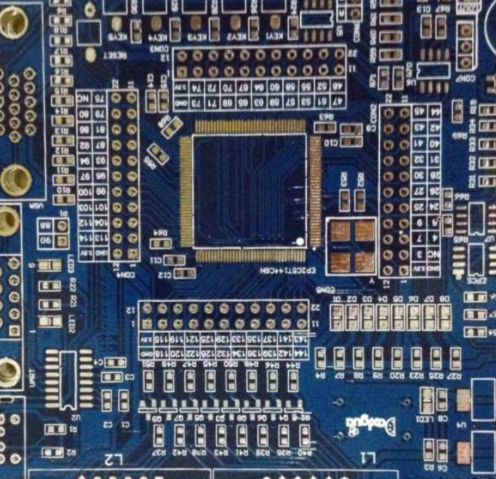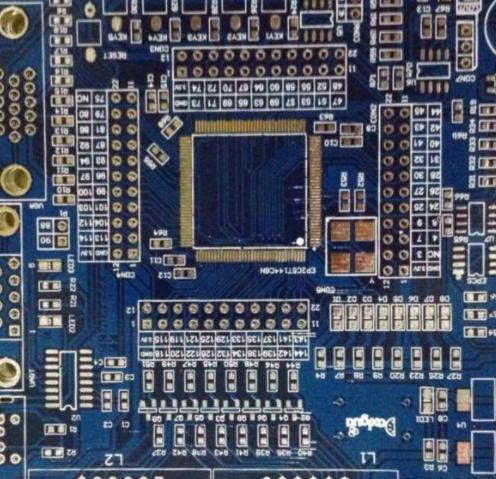
Mechanical cutting method of printed circuit board
1 Cut
Shearing is a step in the mechanical operation of the PCB The basic cutting method is applicable to a variety of base materials, and the thickness usually does not exceed 2 mm. When the cutting plate exceeds 2 mm, the cutting edge will become rough and uneven. In summary, this method is not usually used
Laminate shearing can be manual or electromechanical operation, no matter which method has common characteristics in operation The shear usually has a set of adjustable shear blades, as shown in Figure 10-1 The blade is rectangular, the bottom edge has an adjustable angle of about 7 °, the cutting length can reach 1000mm, and the longitudinal angle between the two blades is usually 1 ° - 1 5 °, use epoxy glass substrate that can reach 4 °, and the gap between two blades is less than 0.25mm
pcb board

Select the angle between two blades according to the thickness of the cutting data The thicker the data, the greater the angle required If the shearing angle is too large or the gap between the two blades is too wide, the cardboard will crack when cutting the paper substrate However, for the epoxy glass substrate, the circuit board will deform even if there is no crack because the data has a certain bending strength Keep the edge of the substrate clean during shearing, and the data can be heated within the range of 30-100 ° C In order to obtain a clean cut, the plate must be securely fastened with a spring mechanism to prevent other unavoidable displacements of the plate during shearing In addition, parallax may also lead to a tolerance of 0.3 0.5 rnrn, which should be reduced to 0.3 rnrn. Angle ruler should be used to improve accuracy The shear can handle various sizes and can provide repeated sizes Large machines can cut hundreds of kilograms of substrates per hour
2. Sawing
Sawing is another method of cutting substrates. Although the dimensional tolerance of this method is preferable to shearing (0.3 - 0.5 rnrn), because the cutting edge is very smooth and neat In PCB manufacturing, circular saws with movable worktables are mainly used The speed of saw blade can be adjusted between 2000-6000r/rnin However, after setting the cutting speed, it cannot be changed It uses heavy-duty pulleys with multiple V-belts to achieve this
The diameter of the high-speed moving steel blade is about 3000rnrn. It can cut paper data/rnin at a speed of 2000-3000r. There are 5 teeth per 1cm circumference It is used for epoxy glass substrate and tungsten carbide blade The cutting effect of diamond wheel is better. Although it was a big investment at the beginning, it can improve the cutting effect due to its long service life, which is very useful for future work Here are a few things to pay attention to when using a cutting machine:
1) Pay attention to the cutting force acting directly on the edge and check the firmness of the bearing. There should be no abnormal sentiments when exa minimum value ed by hand;
2) For safety reasons, the teeth should always be covered by a protective device;
3) The mounting shaft and engine should be placed accurately;
4) There should be a gap between the saw blade and the bracket, so that the board has a good support for edge cutting;
5) The circular saw should be adjustable, and the height range between the blade and the board should be 10-15mm;
6) Blunt teeth and too rough teeth will make the cutting edge not smooth, so replace it;
7) Wrong cutting rate will cause the cutting edge to be unsmooth, which should be adjusted appropriately. Thick materials need to be slow, while thin materials can be cut quickly;
8) It should operate at the speed given by the manufacturer;
9) If the saw blade is thin, reinforcing pads can be added to reduce vibration
3. Punching
When the printed circuit board design has other shapes or irregular contours in addition to the rectangle, it is a faster and more economical method to use die cutting dies The basic stamping operation can be performed with a punch, which produces a cleaner edge than with a saw or shear Sometimes, you can even drill and punch at the same time However, when good edge effect or strict tolerance is required, die cutting is insufficient In the printed circuit board industry, die cutting is usually used to cut paper substrate, but rarely used to cut epoxy glass substrate Die cutting makes the cutting tolerance reach to be within ± (0.1-o. 2mm) of PCB
1) Punching of paper substrates
Since the paper substitute is soft than the epoxy glass substitute, it is more suitable for die cutting When cutting paper substrate with die-cutting tools, consider the springback or curvature of data Because the paper substrate often rebounds, usually, the die-cutting part is slightly larger than the mold Therefore, the size of the die should be selected according to the tolerance and thickness of the substrate, which is slightly smaller than the printed circuit board to compensate for the oversize size As people have noticed, when punching, the die is larger than the size of the hole, and when punching, the die is smaller than the normal size For complex shaped circuit boards, use step-by-step tools, such as cutting data one by one As the dies are cut one by one, the shape of the data changes gradually With this kind of pipe, punch in the first step or the second step, and the stamping of other parts is finally completed The heated punching and die cutting can improve the cutting efficiency of PCB, for example, heating the aluminum strip to 50-70 ℃ before die cutting However, be careful not to overheat, as this will reduce flexibility after cooling In addition, attention should be paid to the thermal expansion of paper-based benzoin materials, because it shows different expansion characteristics in z and y directions
2) Punching of epoxy glass substrate
When the desired shape of the epoxy glass abstract cannot be produced by shearing or sawing Because although the function is acceptable, the cutting edge looks irregular Since the resilience of the epoxy glass substrate is less than that of the paper substrate, the tools for stamping the epoxy glass substrate must be closely matched between the die and the punch Die cutting of epoxy glass substrate shall be carried out at room temperature Because the epoxy glass substrate is hard and hard to punch, it will shorten the life of the punch and soon wear Better cutting effect can be obtained by using cemented carbide punch
4. Milling
Milling is typically used where near cut PCB, with smooth edges and high dimensional accuracy The common milling speed is in the range of 1000-3000r/minimum value, and the straight tooth or spiral tooth high-speed steel milling machine is usually used However, for epoxy glass substrates, carbon pigeon tools are used because of their longer service life Avoid layering. When milling, the back of the printed circuit board must have a solid backing For detailed information about the milling machine, tools and other operations, refer to the standard factory or workshop instructions for these equipment
5. Grinding
In order to obtain a better edge effect than shearing or sawing and achieve higher dimensional accuracy When the dimensional tolerance is ± (0.1-0.2mm), it is cheaper than drilling Therefore, in some cases, the extra dimension in die cutting can be trimmed in the subsequent grinding process to obtain a smooth cutting edge Today's multi axis machines make grinding very fast, with less labor and lower total cost compared with stamping When the track of the circuit board is close to the edge, grinding may be the only way to obtain satisfactory cutting quality The basic mechanical operation of grinding is similar to mirror grinding, but its cutting and feeding speed is much faster Refer to the grinding fixture to move the plate along the vertical grinding surface According to the grinding needs, the grinding fixture is fixed on the bushing concentric with the grinding tool The position of the PCB in the grinding fixture is determined by the alignment hole in the document
There are three main grinding systems, they are:
1) Needle grinding system;
2) Track or record the needle grinding system;
3) Numerically controlled (NC) grinding system.
5.1 Needle grinding
Pin grinding is suitable for small batch production The pin grinding system has a steel or aluminum template made according to the precise contour of the printed circuit board, which also provides pins for the positioning of the circuit board There are usually three or four plates stacked on top of the dowel pin protruding from the table Use the same diameter blade and locating pin, and grind the stacked wood plate in the direction opposite to the rotation direction of the tool Generally, because the grinder tends to deflect the plate from the locating pin, it takes approximately two to three grinding cycles to ensure the correct grinding path Although the needle grinding system requires high labor intensity and requires highly skilled operators, its high precision and smooth cutting edge make it suitable for grinding small batches and irregular shaped plates
5.2 Track grinding
The tracking grinding system uses a template for cutting just like the needle grinding system. Here, the stylus tracks the outline of the circuit board on the template The recording needle can control the movement of the drill shaft on the fixed table, or, if the drill shaft is fixed, it can control the movement of the workbench The latter is usually used for multi drilling machines The mold is manufactured according to the contour of the cutting plate, with a stylus tracking the contour at its outer edge The cutting step is traced to the outer edge by the stylus In the second step, the stylus tracks the inner edge, which removes most of the load from the grinder to better control the cut size The recording needle system is more accurate than the needle system 0l0in(0. 25mm) Using general operating techniques can make the tolerance of products produced in batch reach ± 0l0in (0.25mm) Up to 20 plates can be milled simultaneously using a multi axis machine
5.3 NC grinding system
Computer Numerical Control (CNC) technology with multiple drill spindles is the method of grinding in today's printed circuit board manufacturing industry. When the output of products is large and the contour of printed circuit board is complex, NC grinding system is usually selected In these equipment, the movement of the table, the drill shaft and the cutting machine are controlled by the computer, while the machine operator is only responsible for loading and unloading Especially in large-scale production, the cutting tolerance of complex shapes is very small







